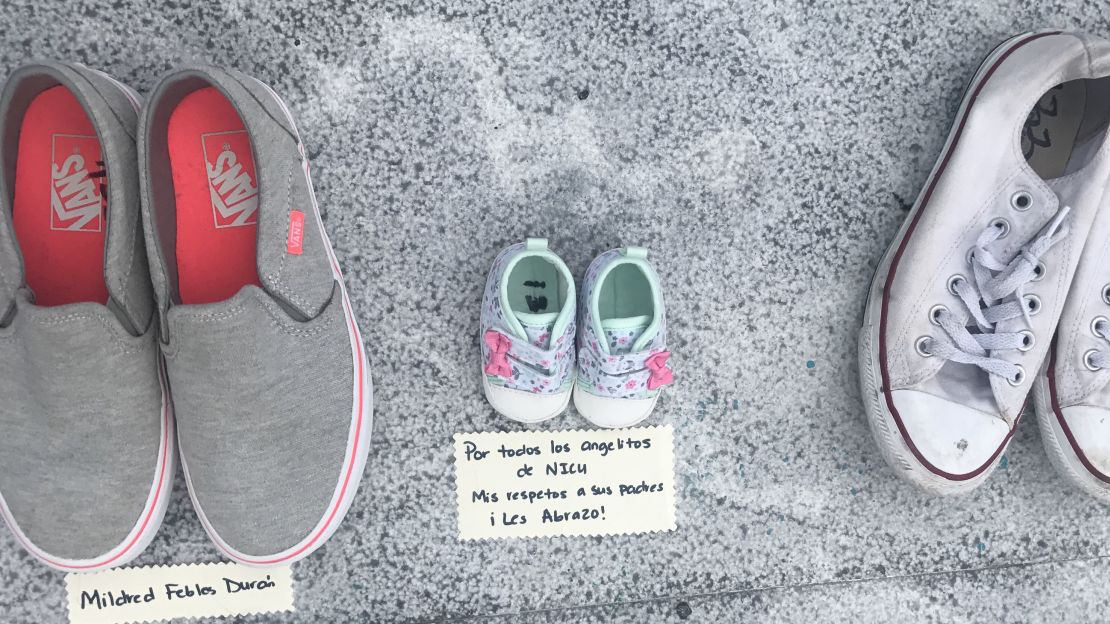Puerto Ricans laid out hundreds of shoes Saturday in front of the US territory’s Capitol in a makeshift memorial to those killed by Hurricane Maria – wrapping up a week in which two reports brought fresh questions about how many people died from last year’s devastating storm.
Residents placed more than 1,600 pairs of shoes in front of the building, some with notes and flowers honoring one or more people. Visitors hugged one another, or looked on in tears.
Emma Rodriguez sobbed when she arrived with Alberto Martinez. They came from Aguadilla, and left shoes for Jonathan Goitia and Abner DeJesus. DeJesus had a medical condition that worsened after Maria, when he couldn’t get medical attention he needed. Goitia, Rodriguez said, was found dead in his home.
“I can smell the death. This is death,” Rodriguez said.
Most people left written messages with the shoes, such as, “You will rejoice when you see me in the place that no eye has seen…” and “Today I am lending your shoes for a cause.” And some mourners expressed anger.
“Donald Trump had the nerve to say this wasn’t that big of a deal compared to (Hurricane) Katrina,” Arturo Alvarez said. “There are no words to describe how disrespectful it was” for him to say that.
“Now is the time to say goodbye to the relatives, is the time (for) sorrow, is the time to hug each other,” memorial organizer Gloribel Delgado told CNN. “So it’s the time to really say a goodbye in honor and dignity.”

University of Puerto Rico professor Rafael Acevedo is credited with coming up with the idea for the shoe memorial. Delgado said the shoes will be left out until Sunday, then moved to other municipalities hurt by the storm.’
The memorial came as a controversy swirls over the government’s official death toll of 64 from the storm that slammed into the Caribbean island on September 20.
On Friday, the US commonwealth’s government released data showing deaths on the island spiked sharply around the time Hurricane Maria hit – perhaps dovetailing with assertions that the official storm death toll is far too low.
The data show an increase of 1,431 overall deaths on Puerto Rico in September, October and November 2017 compared with the same three months a year earlier, and a jump of 1,720 deaths compared with the same three months in 2015.
However, the raw data released Friday by the island’s demographic registry does not specify causes of death – so it is unclear how much of the spike could be related to the storm.
The data release comes days after a Harvard University study estimated that 4,645 people died from Maria and its aftermath – 70 times greater than the island’s official death toll.
CNN and other news outlets have used government statistics and extensive interviews with families of the deceased and funeral home directors to question the Puerto Rican government’s official tally of deaths.
CNN and the Center for Investigative Journalism (CPI) in Puerto Rico are suing the island’s demographic registry for access to death records that have been withheld.
On Thursday, Gov. Ricardo Rosselló said he did not stand by the official death toll, and that he welcomed the Harvard study results. But he said his government did the best it could with information-gathering protocol available at the time.
“We had established that this number was going to be much, much higher than what we had as an official tally,” he told CNN’s Anderson Cooper.
“It’s not sticking with the number. It was just establishing that the process that we had prior led us to that number, which is what we got from doctors and death certificates.”
Maria wiped out Puerto Rico’s power grid, leaving the entire island in the dark in September. While most power and water service has been restored, thousands of people remain without electricity more than eight months after the storm hit.
CNN’s Leyla Santiago reported from San Juan, and CNN’s Jason Hanna wrote and reported in Atlanta. CNN’s John Sutter, Emanuella Grinberg and Dave Alsup contributed to this report.



















